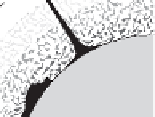Geoscience Reference
In-Depth Information
Subduction zone
Hot spot
Continent
Mid-ocean
ridge
Core
Figure 11.15
A compromise model of mantle convection (modified from Albarède and van der Hilst,
2002
)
. The
660 km discontinuity has some holes which let large plates and plume heads through. Because of
trench roll-back, some plates flatten and rest on the discontinuity for a few tens of Ma before
foundering across the transition zone. The lower mantle is an intimate mixture of primordial and
recycled material. The latter comprises both the refractory residues of melting at mid-ocean
ridges and subducted oceanic crust severely outgassed at subduction zones. Helium with high
3
He/
4
He values and solar neon soak most of the lower mantle.
(
Fig. 11.15
). A combination of these two effects would justify the presence of U, Th, and
K at depth and a reasonable Urey ratio while at the same time leaving room for some
whiffs of ancient rare gases to be felt in rocks that otherwise carry all the signs of recycled
material in their source. We have seen that a primitive signal in basalts is not necessarily
equivalent to a primitive source. One way of explaining the Ar paradox is to change the
terrestrial K/U ratio by 30 percent. Large holes, megaplumes and avalanches through the
transition zone may actually account for most of the traffic between the upper and the lower
mantle. If the 660 km transition zone is not taken to be an effective barrier, subduction
zones still act as filters. As the material enriched in lithophile elements, which makes up
the continental crust, is extracted at subduction zones, the material penetrating into the
lower mantle must be greatly depleted but still rich in basaltic components. Moreover,
the subducted oceanic crust transforms under pressure into eclogite, a very dense rock
compared with the remainder of the oceanic lithosphere. It will tend to become delaminated
and to accumulate by gravity at the base of the mantle and to build up an important reserve
of fusible elements. The emerging picture is therefore that of a zoned more than a fully
layered mantle. The lower part is both the plate graveyard of the one-layer model and the
repository of primordial material of the two-layer model. It is soaked in primordial rare
gases and may locally contain some remains of the early planetary differentiation (see
the discussion of 142 anomalies in the next chapter). Plumes initiate at the bottom of the
mantle because this is where temperatures are the highest and therefore densities are the
lowest. The particularly strong buoyancy allows mantle upwellings to rise all the way to
the surface. The upper part of the mantle may contain essentially the same components,
which is why tenuous OIB flavor is occasionally present in MORB and continental basalts,
but the proportion of identifiable ancient material is much smaller, probably because of
efficient mixing.











































































































































































































































































































































